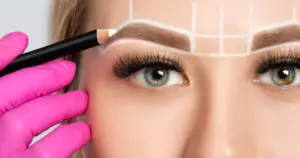Hyaluronic acid vs Retinol [with Benefits, Side effects and Usage Instructions]
![Hyaluronic acid vs Retinol [Benefits, Side-effects, Proven ways to use]](https://keevs.com/wp-content/uploads/2021/09/Hyaluronic-acid-vs-Retinol-Benefits-Side-effects-Proven-ways-to-use.jpg)
Healthy skin is always in! Show your skin a little love with Hyaluronic acid and Retinol – the skincare superstars!
Hyaluronic acid and Retinol are skincare superstars without a doubt. Whether you’re a seasoned skincare guru or just getting started, do you recognize the differences between the two?
Many of us are so preoccupied with routine activities that we often neglect our skin and hair. Good hair days just sound like a dream to us and skincare is just a fantasy!
When it comes to beauty truisms, retinol and hyaluronic acid hit the top-notch! Continue reading Hyaluronic v/s Retinol to find out which one is better.
What is Hyaluronic Acid?
Hyaluronic acid is naturally present in the human body. The largest concentrations are seen in the fluids of the eyes and joints.
Hyaluronic acid (HA) regulates a variety of biological processes, including skin repair, cancer detection, wound repair, tissue formation, anti-inflammation, and immune regulation [1].
Hyaluronic acid is a natural humectant that attracts water to itself. It is made up of amino acids and sugar molecules.
It can store 1,000 times its weight in water and, in conjunction with collagen and elastin, it aids in tissue structural stability, resulting in softer, healthier skin.
Hyaluronic acid has a wide range of applications. It’s taken as a supplement by many individuals, but it’s also found in topical serums, eye drops, and injections.
Benefits of Hyaluronic Acid
The following are some scientifically proven perks of using hyaluronic acid.
1. Helps with Wound and Scar healing
Hyaluronic acid is also important in wound healing.
It is normally present in the skin, but concentrations rise when there is damage that needs to be repaired.
Hyaluronic acid promotes wound healing by reducing inflammation and signaling the body to generate more blood vessels in the affected area [2].
Keloids are harmless dermal scars. Hyaluronic acid aids in the prevention of keloid scarring [3].
Since hyaluronic acid is antimicrobial, it can help lower the risk of infections when applied directly to open wounds [4].
While research on hyaluronic acid serums and gels has been positive, no studies have been conducted to evaluate whether hyaluronic acid supplements can deliver the same advantages.
However, because oral supplements increase the amounts of hyaluronic acid in the skin, it is reasonable to believe they may be beneficial.
2. Promotes Healthier Skin
The typical aging process, as well as exposure to UV rays from the sun, cigarette smoke, and pollution, can reduce HA levels in the skin [5].
Hyaluronic acid can dramatically reduce the depth of wrinkles while also improving skin suppleness and elasticity [6].
When a person’s skin changes, it might have a negative psychological impact. This can come about as a result of aging. An old study discovered that hyaluronic acid can help to reduce skin dryness and promote skin suppleness [7].
3. Aids in Dermatitis
The use of hyaluronic acid can assist to alleviate the symptoms of mild – to – moderate eczema.
Hyaluronic acid in the form of foam was deemed to be more pleasant to use and to relieve eczema symptoms better than a ceramide-containing emulsion cream by research subjects [8].
4. Promotes Hair Growth
Hyaluronic acid may aid in the growth of healthy hair. It’s thought to work as a fertilizer, nourishing the hair and scalp and encouraging cell regeneration. According to anecdotal evidence, it promotes hair growth and thickness.
Hair loss is frequently caused by the weakening of hair strands, which makes them more vulnerable to breakage when brushed or washed.
Higher hyaluronic acid helps hair strands retain moisture without depleting the structure, which may prevent hair loss.
Side effects of Hyaluronic Acid
Hyaluronic acid is usually considered to be a relatively safe substance to use, with very few known negative effects.
Allergies are uncommon because hyaluronic acid is produced naturally by the body. There’s also evidence that cancer cells are resistant to hyaluronic acid, and that supplementing with it can speed up their growth [9].
Injections of hyaluronic acid into the skin or joints carry a higher risk of negative reactions. Negative reactions, on the other hand, are usually linked to the injection method rather than hyaluronic acid alone [10].
What is Retinol?
Your skin is your wand! You can turn things magical if you take proper care!
To stay confident in yourself depends a lot on how confident you feel in your skin. Acne should never be the reason to make you underconfident. But just in case you feel low, try these hacks to make your day!
Retinol is frequently hailed as a skin-care shining star. However, there are plenty of awful stories to go along with the positive ones.
Some people claim that retinol has damaged their skin, while others are afraid to try it. But is it so? Let’s look at some science-backed benefits to solve our query.
One of the most well-known skin-care ingredients is retinol. Retinols are vitamin A derivatives that are used to treat anti-aging and acne issues.
It is a member of the retinoids family of vitamin A compounds. According to a study, retinol has the power to influence the skin structure during dermatological treatments [11].
Benefits of Retinol
1. Fights Acne
Do you have acne that is resistant to treatment? Retinol might be exactly what you’re looking for. Retinol clears the skin and prevents future breakouts by unclogging pores.
Acne scars are naturally reduced when there is less acne. Furthermore, retinoids can enhance the effects of other medicated creams and gels, letting you get the most out of your treatments [12].
2. Anti-aging properties
You can relax knowing that retinol is one of the most broadly applied and researched anti-aging compounds available! Tretinoin was first promoted as an anti-acne treatment in the 1970s, but it quickly unveiled its significant anti-aging properties.
Tretinoin is arguably the most effective and probably the most researched retinoid for photoaging therapy among the retinoids.
Although retinoids show potential in the treatment of skin aging, irritating reactions such as burning, scaling, or dermatitis are common side effects of retinoid therapy [13].
Side effects of Retinol
- While retinol can be used on all skin types and textures, the negative effects differ depending on the percentage of retinol used and how it is applied.
- Irritation has been reported among first-time retinol users, including redness, dryness, and peeling.
- You may have additional discomfort, such as itching and scaly spots if you use too strong a dose or apply retinol more often than recommended.
Hyaluronic Acid v/s Retinol
The fundamental distinction between hyaluronic acid and retinol is that hyaluronic acid is moisturizing, whereas retinol is an antioxidant that promotes skin cell regeneration.
Retinol, on the other hand, is said to boost all 3 kinds of hyaluronic acid naturally found in your skin, as well as the synthesis of hyaluronic acid in your dermis. It still does, however, take a long time to do so [14].
Let’s compare the qualities of hyaluronic acid and retinol for different conditions.
Hyaluronic acid v/s Retinol for Wrinkles
Let’s compare the properties both possess for reducing wrinkles.
| Hyaluronic Acid | Retinol |
| Makes wrinkles less visible by moisturizing your skin | Reduces wrinkles by stimulating the production of new blood cells |
| Enhances your skin | Increases collagen formation |
| Tightens your skin | Neutralize free radicals |
When compared, both the shining stars are one of a kind! Both focus on reducing wrinkles but in different ways.
Hyaluronic acid v/s Retinol for Stretch marks
Stretch marks do not need to be treated. They are completely harmless and usually fade away with time. They may shrink with treatment, but they may never totally disappear.
Let’s compare the properties both possess for reducing stretch marks.
| Hyaluronic Acid | Retinol |
| HA makes the marks less noticeable | The cream may improve the marks |
| It moisturizes damaged skin | It may promote elasticity |
Hyaluronic acid v/s Retinol for Dark circles
Unfortunately, aging in the under-eye area occurs in strata, which is why your skin sags gradually from your eyelids to your eyebrows to your forehead.
If cosmetic surgeries aren’t an alternative for you, you can reduce the impression of dark circles with over-the-counter moisturizing creams and skincare solutions.
| Hyaluronic Acid | Retinol |
| Hydrates the skin | Reduces fine lines |
| Provides a radiant glow | Improve texture and skin tone |
Let us now solve the queries that may be striking your mind now!
Hyaluronic acid or Retinol: Which one to use first?
There aren’t many topical skincare products that can compete with the advantages of retinoids, which span from acne prevention to anti-aging.
Hyaluronic acid can be used first to avoid irritation.
When coupling retinoids with moisturizing substances like hyaluronic acid, it’s better to start with the retinoid.
But many people find them difficult to tolerate (at first) and report extreme dryness, which may discourage its use.
It hydrates and soothes without interfering with the capacity of the retinol to do its work [15].
Can you use Hyaluronic Acid and Retinol together?
It is safe to combine hyaluronic acid and retinol. The use of skincare products containing these components combined should not result in any interactions or negative effects.
Among the most popular skincare combinations are hyaluronic acid and retinol. This is because the properties of hyaluronic acid can help to alleviate the negative effects of retinol.
Is it safe for all skin types?
Since hyaluronic acid is so versatile, it may be combined with almost any skincare product. This includes retinol, vitamin C, alpha, and beta hydroxy acids (BHAs). The balance of your schedule doesn’t need to be adjusted as a result.
| The use of Hyaluronic acid and Retinol together is still under review and hence is not backed by many shreds of evidence. |
How to use hyaluronic acid and retinol in combo?
- Cleanse your face with lukewarm water and a gentle face wash or soap before applying anything.
- Using a damp towel, gently pat your skin dry. Avoid rubbing your skin, since this can irritate it and aggravate acne and skin aging.
- Squeeze a minimal amount of retinol cream onto your fingers. Gently apply on your face with care, concentrating on areas damaged by aging and/or acne.
- Before applying your hyaluronic acid moisturizer, wait at least 20 minutes. This gives the retinol cream time to dry and penetrate your skin.
- Nourish your skin with a hyaluronic acid moisturizer after you’ve applied the retinol cream. When using a product, carefully read the instructions.
Wrapping up
Hyaluronic acid and retinol have been shown to have significant, scientific advantages for your skin.
Hyaluronic acid is great for hydrating your skin, while retinol and other retinoids are great for acne prevention and for making wrinkles, fine lines, and other common indicators of aging less obvious on your skin.
Since not much information is available for the suitability of the products on different skin types, you can speak to your Dermatologist before applying them.
References:
- Bukhari, Syed Nasir Abbas et al. “Hyaluronic acid, a promising skin rejuvenating biomedicine: A review of recent updates and pre-clinical and clinical investigations on cosmetic and nutricosmetic effects.” International journal of biological macromolecules vol. 120,Pt B (2018): 1682-1695.
- Litwiniuk, Malgorzata et al. “Hyaluronic Acid in Inflammation and Tissue Regeneration.” Wounds: a compendium of clinical research and practice vol. 28,3 (2016): 78-88.
- Hoffmann, Andrea et al. “Role of Hyaluronic Acid Treatment in the Prevention of Keloid Scarring.” The journal of the American College of Clinical Wound Specialists vol. 4,2 23-31.(2013).
- Zamboni, Fernanda et al. “On the bacteriostatic activity of hyaluronic acid composite films.” Carbohydrate polymers vol. 260 (2021): 117803.
- Simpson, Russell ML et al. “Age-related changes in pericellular hyaluronan organization leads to impaired dermal fibroblast to myofibroblast differentiation.” The American journal of pathology vol. 175,5 (2009): 1915-28.
- Oe, Mariko et al. “Oral hyaluronan relieve wrinkles: a double-blinded, placebo-controlled study over a 12-week period.” Clinical, cosmetic and investigational dermatology vol. 10 267-273. (2017).
- Kerscher, Martina et al. “Rejuvenating influence of a stabilized hyaluronic acid-based gel of non-animal origin on facial skin aging.” Dermatologic surgery: official publication for American Society for Dermatologic Surgery [et al.] vol. 34,5 (2008): 720-6.
- Draelos, Zoe Diana. “A clinical evaluation of the comparable efficacy of hyaluronic acid-based foam and ceramide-containing emulsion cream in the treatment of mild-to-moderate atopic dermatitis.” Journal of cosmetic dermatology vol. 10,3 (2011): 185-8.
- Itano, Naoki et al. “Impact of the hyaluronan-rich tumor microenvironment on cancer initiation and progression.” Cancer science vol. 99,9 (2008): 1720-5.
- Adams, M E et al. “A risk-benefit assessment of injections of hyaluronan and its derivatives in the treatment of osteoarthritis of the knee.” Drug safety vol. 23,2 (2000): 115-30.
- Zasada, Malwina, and Elżbieta Budzisz. “Retinoids: active molecules influencing skin structure formation in cosmetic and dermatological treatments.” Postepy dermatologii i alergologii vol. 36,4 (2019): 392-397.
- Leyden, James et al. “Why Topical Retinoids Are Mainstay of Therapy for Acne.” Dermatology and therapy vol. 7,3 (2017): 293-304.
- Mukherjee, Siddharth et al. “Retinoids in the treatment of skin aging: an overview of clinical efficacy and safety.” Clinical interventions in aging vol. 1,4 (2006): 327-48.
- Li, Wen-Hwa et al. “Topical stabilized retinol treatment induces the expression of HAS genes and HA production in human skin in vitro and in vivo.” Archives of dermatological research vol. 309,4 (2017): 275-283.
- Bauza, E et al. “Collagen-like peptide exhibits a remarkable anti-wrinkle effect on the skin when topically applied: in vivo study.” International journal of tissue reactions vol. 26,3-4 (2004): 105-11.



![Top 5 Benefits of Collagen for Hair [With Best Foods]](https://keevs.com/wp-content/uploads/2023/01/Collagen-for-Hair-300x158.png)



